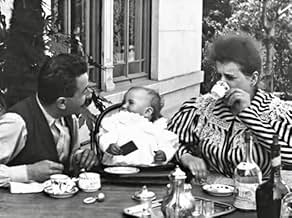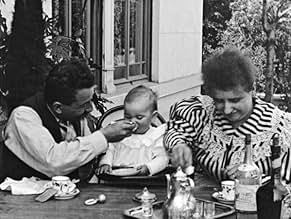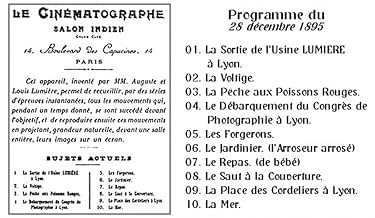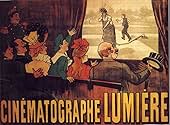Repas de bébé
- 1895
- 1m
IMDb RATING
5.9/10
3.7K
YOUR RATING
As part of a maiden public film screening at the Salon Indien, on December 28, in Paris, Auguste Lumière pivots the centre of attention around his baby daughter, as he tries to feed her from... Read allAs part of a maiden public film screening at the Salon Indien, on December 28, in Paris, Auguste Lumière pivots the centre of attention around his baby daughter, as he tries to feed her from a spoon.As part of a maiden public film screening at the Salon Indien, on December 28, in Paris, Auguste Lumière pivots the centre of attention around his baby daughter, as he tries to feed her from a spoon.
Featured reviews
This film, along with nine other films, was shown at a Paris, mini-film festival, by pioneering filmmakers, the Lumiere brothers, in December of 1895. The seventh film ever shown to a paying audience, ends up being the first sequel too, when August Lumiere brings his kid back out for lunch time with the wife. They are both the main subjects in an earlier Lumiere film, shown about two minutes before this one, Fishing For Goldfish (1895). Watching this during a mini-festival in 1895 probably didn't register as a sequel. But looking back at it 130 years later, it is a prime, early example of a sequel. The baby must have tested well during all the test screenings. This is what is so cool watching films from the pioneering era of film.
7.8 (B- MyGrade) = 8 IMDB.
7.8 (B- MyGrade) = 8 IMDB.
One of the first films ever made, the film seems extremely primitive: there is no dialogue or plot or characters. However, in 1895, it was a new technological breakthrough. It is interesting to watch; the Lumière brothers were the first film makers and pretty much invented the technology, along with Edison.
The pleasant domestic scene in this early Lumière feature is nicely photographed, and it essentially allows the viewer to share in a peaceful moment with a family from a long-past era. It has fortunately been preserved in excellent condition, so that the detail and composition can be appreciated.
This is one of many very early moving pictures that showed how much more a movie could do than a still photograph. As simple and calm as all of the actions are in this feature, they bring the scene to life, making it feel less like an event from the distant past, and more like a short visit with living beings. Whether by chance or by design, the swaying leaves in the background which are caught quite clearly add an extra dose of realism.
As a result of all of these things, the outdoor setting is convincing, and the simple scene is an endearing one that is worth watching.
This is one of many very early moving pictures that showed how much more a movie could do than a still photograph. As simple and calm as all of the actions are in this feature, they bring the scene to life, making it feel less like an event from the distant past, and more like a short visit with living beings. Whether by chance or by design, the swaying leaves in the background which are caught quite clearly add an extra dose of realism.
As a result of all of these things, the outdoor setting is convincing, and the simple scene is an endearing one that is worth watching.
On a cold day of December in 1895, two photo technicians named Auguste and Louis Lumière rented the Salon Indien Du Grand Café to show the results of a series of experiments they had been making since 1892. As workers of their father's photographic firm, their work in the development of better process to make photographs wasn't unknown, but what the brothers showed to their limited audience that day was far beyond what anyone could have imagined. On that day, cinema was born, as the brothers' invention, the Cinématographe, allowed to project moving images on a screen, a considerable improvement over the popular Kinetoscope (which showed the images through a peephole). As photographers themselves, the brothers considered their invention to be the natural evolution of photography, so most of the movies they showed that day were done to show the idea that like photography, cinema was here to capture memories, albeit in a more vivid way.
Of the 10 short films the brothers screened on that historical day, most were of course devised to show the movement of the images (people walking, exercising, or simply the traffic passing on the street), but the others had specific purposes to show the brothers' ideas of what kind of uses give to the new invention. One was of course the shooting of the arrival of the Congress of Photographers in Lyon, aimed to show cinema as a new way to document history; there was also "L'Arroseur Arrosé", which showed cinema as a way to tell a simple and fun little story; and finally, there were the movies that, like photographs, captured family moments. "Repas De Bébé" (literally, "Baby's Meal") was one of that kind of movie, as the film showed Auguste Lumière and his wife Marguerite, while they are having breakfast with their baby daughter Andrée.
While one could even say that the movie doesn't have anything special besides the fact that it was among the first movies screened in history; "Repas De Bébé" is probably the movie that represents the Lumières' ideal of cinema the most, as like a photography, the movie captures a charming moment in the life of a family that can be revisited anytime, with the advantage of having it moving. This meant that we could not only remember how persons looked in the past, we were now able to see how they behaved, what they did or simply how they really lived. It was more than a documentary or an actuality film, this was essentially a memory being caught on film and saved for posterity. One can make the argument that film videos were born with this movie, and for that reason alone, "Repas De Bébé" has a special place in the history of film. 6/10
Of the 10 short films the brothers screened on that historical day, most were of course devised to show the movement of the images (people walking, exercising, or simply the traffic passing on the street), but the others had specific purposes to show the brothers' ideas of what kind of uses give to the new invention. One was of course the shooting of the arrival of the Congress of Photographers in Lyon, aimed to show cinema as a new way to document history; there was also "L'Arroseur Arrosé", which showed cinema as a way to tell a simple and fun little story; and finally, there were the movies that, like photographs, captured family moments. "Repas De Bébé" (literally, "Baby's Meal") was one of that kind of movie, as the film showed Auguste Lumière and his wife Marguerite, while they are having breakfast with their baby daughter Andrée.
While one could even say that the movie doesn't have anything special besides the fact that it was among the first movies screened in history; "Repas De Bébé" is probably the movie that represents the Lumières' ideal of cinema the most, as like a photography, the movie captures a charming moment in the life of a family that can be revisited anytime, with the advantage of having it moving. This meant that we could not only remember how persons looked in the past, we were now able to see how they behaved, what they did or simply how they really lived. It was more than a documentary or an actuality film, this was essentially a memory being caught on film and saved for posterity. One can make the argument that film videos were born with this movie, and for that reason alone, "Repas De Bébé" has a special place in the history of film. 6/10
Repas de bebe (1895)
This early film from Louis Lumiere is pretty simple as a mom and dad are facing the camera with their child sitting between them. They feed the baby. Yep, that's all that happens in this early film but it's a pretty interesting experiment. Of course, this was 1895 so it's silly to try and compare this film to the film's of today. Things were so early at this point that people like Lumiere were just filming whatever they could. If you've got children then this here will obviously appeal to you as it's quite funny to see the baby's reaction to all this food coming its way.
This early film from Louis Lumiere is pretty simple as a mom and dad are facing the camera with their child sitting between them. They feed the baby. Yep, that's all that happens in this early film but it's a pretty interesting experiment. Of course, this was 1895 so it's silly to try and compare this film to the film's of today. Things were so early at this point that people like Lumiere were just filming whatever they could. If you've got children then this here will obviously appeal to you as it's quite funny to see the baby's reaction to all this food coming its way.
Did you know
- TriviaFilm historians often jokingly refer to this film as the first 'home movie,' as it depicts the filmmaker's home life in a documentary fashion, without any attempt at narrative contrivances.
- ConnectionsEdited into The Lumière Brothers' First Films (1996)
Details
- Release date
- Country of origin
- Language
- Also known as
- Le déjeuner de bébé
- Production company
- See more company credits at IMDbPro
- Runtime
- 1m
- Color
- Sound mix
- Aspect ratio
- 1.33 : 1
Contribute to this page
Suggest an edit or add missing content



















